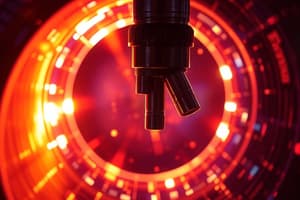Podcast
Questions and Answers
What is the primary purpose of interference microscopy?
What is the primary purpose of interference microscopy?
- To achieve a low magnification of specimens
- To stain cells for better visibility
- To provide improved image contrast and color graduation (correct)
- To measure the temperature of living cells
What artifact is commonly associated with phase contrast microscopy?
What artifact is commonly associated with phase contrast microscopy?
- Phase halo (correct)
- Color gradient
- Cell misalignment
- Light diffraction
In interference microscopy, what mechanism separates retarded rays from direct rays?
In interference microscopy, what mechanism separates retarded rays from direct rays?
- Illumination source
- Condenser
- Optical lenses
- Phase plate (correct)
Which component in the interference microscope focuses on the specimen plane?
Which component in the interference microscope focuses on the specimen plane?
What does optical weighing in interference microscopy help to measure?
What does optical weighing in interference microscopy help to measure?
What is one of the advantages of using polarized light microscopy?
What is one of the advantages of using polarized light microscopy?
What type of sections can be efficiently examined with interference microscopy?
What type of sections can be efficiently examined with interference microscopy?
Which measurement is not improved by interference microscopy?
Which measurement is not improved by interference microscopy?
What type of image is formed by the eyepiece of a microscope?
What type of image is formed by the eyepiece of a microscope?
What is one of the main uses of chromatic aberration free (CF) optics?
What is one of the main uses of chromatic aberration free (CF) optics?
What causes spherical aberration in lenses?
What causes spherical aberration in lenses?
Which of the following is a potential distortion in microscope images?
Which of the following is a potential distortion in microscope images?
What is the function of the substage condenser in a microscope?
What is the function of the substage condenser in a microscope?
Which light source is most currently used in modern microscopes?
Which light source is most currently used in modern microscopes?
What can be a result of coma in microscope images?
What can be a result of coma in microscope images?
What material is commonly used to correct optical faults in microscope lenses?
What material is commonly used to correct optical faults in microscope lenses?
What type of light is typically used for exciting fluorochromes in fluorescence microscopy?
What type of light is typically used for exciting fluorochromes in fluorescence microscopy?
Which type of filters allows a narrow band of wavelengths to pass through?
Which type of filters allows a narrow band of wavelengths to pass through?
What is the purpose of barrier or suppression filters in fluorescence microscopy?
What is the purpose of barrier or suppression filters in fluorescence microscopy?
What substance can naturally fluoresce without the addition of dyes?
What substance can naturally fluoresce without the addition of dyes?
To achieve optimum results with vitamin A, which wavelength is the excitation light typically?
To achieve optimum results with vitamin A, which wavelength is the excitation light typically?
What is a common characteristic of the majority of fluorochromes?
What is a common characteristic of the majority of fluorochromes?
How are narrow band filters typically constructed?
How are narrow band filters typically constructed?
What happens if a barrier filter does not allow the fluorescing color to pass?
What happens if a barrier filter does not allow the fluorescing color to pass?
What is the primary function of a K.470 filter in excitation beams?
What is the primary function of a K.470 filter in excitation beams?
Which type of condenser is recommended to minimize disturbing autofluorescence?
Which type of condenser is recommended to minimize disturbing autofluorescence?
How much of the available energy is typically used in dark field illumination systems?
How much of the available energy is typically used in dark field illumination systems?
What is the role of dichroic mirrors in fluorescence microscopy?
What is the role of dichroic mirrors in fluorescence microscopy?
Which statement about simple achromatic objectives is true?
Which statement about simple achromatic objectives is true?
What is the main disadvantage of bright field condensers in microscopy?
What is the main disadvantage of bright field condensers in microscopy?
Which factor enhances the brilliance of fluorescence in an observation system?
Which factor enhances the brilliance of fluorescence in an observation system?
What happens to excitation rays bouncing back from the slide and coverglass?
What happens to excitation rays bouncing back from the slide and coverglass?
What is the primary function of the wavelength selection filter in the light path for transmitted fluorescence?
What is the primary function of the wavelength selection filter in the light path for transmitted fluorescence?
Which filter is used to protect the observer's eye from excitation wavelengths that could be harmful?
Which filter is used to protect the observer's eye from excitation wavelengths that could be harmful?
What is the role of the heat filter in the light path for fluorescence microscopy?
What is the role of the heat filter in the light path for fluorescence microscopy?
In fluorescence microscopy, which objective types can be used for simultaneous transmitted illumination?
In fluorescence microscopy, which objective types can be used for simultaneous transmitted illumination?
During fluorescence imaging, what purpose does the condenser serve?
During fluorescence imaging, what purpose does the condenser serve?
Flashcards are hidden until you start studying
Study Notes
Image Formation in Microscopes
- Virtual images are formed on the same side as the object, appearing enlarged and upright.
- Cannot be projected; instead, they are viewed through the eyepiece of the microscope.
- Real images are projected by the objective lens to create a virtual image for observation.
Image Quality and Aberrations
- Chromatic aberrations can be corrected using chromatic, aberration-free optics, eliminating color fringes.
- Spherical aberration occurs when light rays are refracted differently based on their entry point on a lens.
- Other distortions include coma, astigmatism, curvature of field, stemming from lens shape and quality.
Components of a Microscope
- A variety of light sources have been employed, ranging from sunlight to modern LEDs.
- The substage condenser directs light from the source to enhance image contrast, aiding in the examination of unstained specimens.
- Interference microscopy provides significant image contrast while allowing for the quantification of optical attributes.
Fluorescence Microscopy
- Ultraviolet radiation, typically around 360-400nm, is used to excite fluorophores, enhancing visibility of certain substances.
- Autofluorescence occurs naturally in some substances without external excitation.
- Secondary fluorescence is induced by adding dyes, chemicals, or antibiotics to tissue samples.
- Narrow band filters refine the light spectrum to optimize fluorescence results.
Filter Mechanisms
- Barrier filters prevent harmful short wavelengths from reaching the observer's eye while allowing fluorescence to be seen.
- Dark field condensers enhance contrast by preventing direct light into the objective, necessary for fluorescence studies.
Incident Light Fluorescence
- Uses above-light sources, illuminating the specimen while the objective collects both exciting and fluorescent light.
- Enables simultaneous transmitted and incident illumination, enhancing overall imaging quality.
Optical Considerations
- Bright field condensers can illuminate objects effectively but may introduce autofluorescence unless used with achromatic objectives.
- Sophisticated lenses with high numerical apertures are beneficial for advanced fluorescence microscopy techniques.
Studying That Suits You
Use AI to generate personalized quizzes and flashcards to suit your learning preferences.




